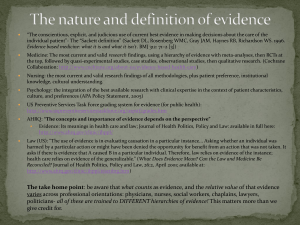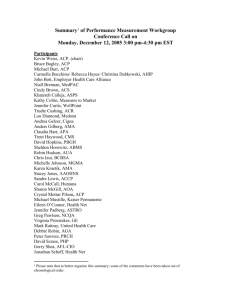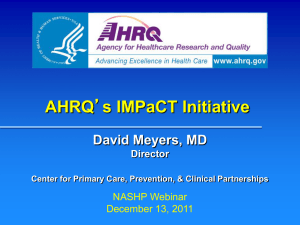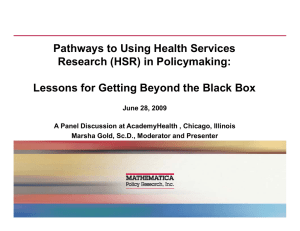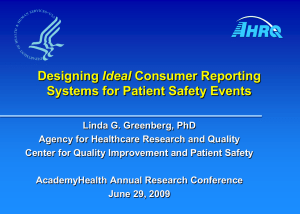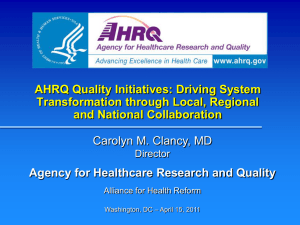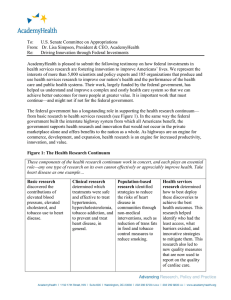6 om as a public service of the RAND Corporation.
advertisement
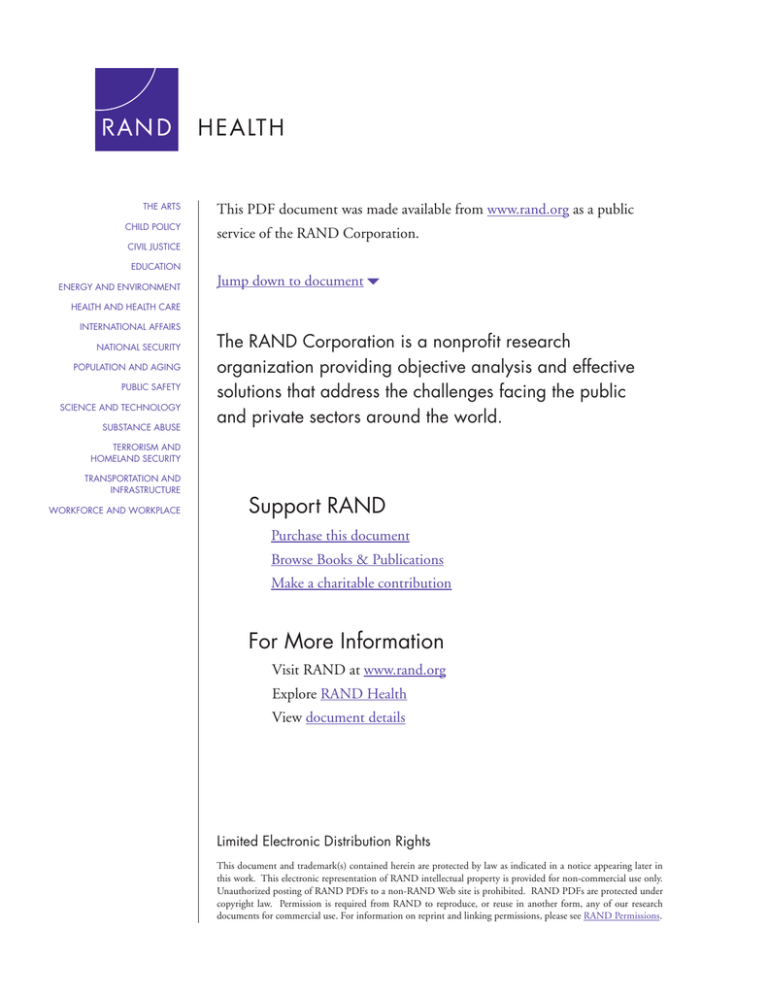
THE ARTS CHILD POLICY CIVIL JUSTICE EDUCATION ENERGY AND ENVIRONMENT This PDF document was made available from www.rand.org as a public service of the RAND Corporation. Jump down to document6 HEALTH AND HEALTH CARE INTERNATIONAL AFFAIRS NATIONAL SECURITY POPULATION AND AGING PUBLIC SAFETY SCIENCE AND TECHNOLOGY SUBSTANCE ABUSE The RAND Corporation is a nonprofit research organization providing objective analysis and effective solutions that address the challenges facing the public and private sectors around the world. TERRORISM AND HOMELAND SECURITY TRANSPORTATION AND INFRASTRUCTURE WORKFORCE AND WORKPLACE Support RAND Purchase this document Browse Books & Publications Make a charitable contribution For More Information Visit RAND at www.rand.org Explore RAND Health View document details Limited Electronic Distribution Rights This document and trademark(s) contained herein are protected by law as indicated in a notice appearing later in this work. This electronic representation of RAND intellectual property is provided for non-commercial use only. Unauthorized posting of RAND PDFs to a non-RAND Web site is prohibited. RAND PDFs are protected under copyright law. Permission is required from RAND to reproduce, or reuse in another form, any of our research documents for commercial use. For information on reprint and linking permissions, please see RAND Permissions. This product is part of the RAND Corporation technical report series. Reports may include research findings on a specific topic that is limited in scope; present discussions of the methodology employed in research; provide literature reviews, survey instruments, modeling exercises, guidelines for practitioners and research professionals, and supporting documentation; or deliver preliminary findings. All RAND reports undergo rigorous peer review to ensure that they meet high standards for research quality and objectivity. Assessment of the AHRQ Patient Safety Initiative Final Report—Evaluation Report IV Donna O. Farley, Cheryl L. Damberg, M. Susan Ridgely, Melony E. Sorbero, Michael D. Greenberg, Amelia M. Haviland, Stephanie S. Teleki, Peter Mendel, Lily Bradley, Jacob W. Dembosky, Allen Fremont, Teryl K. Nuckols, Rebecca Shaw, Susan G. Straus, Stephanie L. Taylor, Hao Yu, Shannah Tharp-Taylor Prepared for the Agency for Healthcare Research and Quality HEALTH This work was sponsored by the Agency for Healthcare Research and Quality (AHRQ) under contract No. 290-02-0010. The research was conducted in RAND Health, a division of the RAND Corporation. Library of Congress Cataloging-in-Publication Data Assessment of the AHRQ patient safety initiative : final report : evaluation report IV / Donna O. Farley ... [et al.]. p. ; cm. Includes bibliographical references. ISBN 978-0-8330-4480-8 (pbk. : alk. paper) 1. Medical errors—Prevention—Government policy—United States. 2. Iatrogenic diseases—Prevention— Government policy—United States. 3. Patients—United States—Safety measures. I. Farley, Donna. II. Rand Corporation. III. United States. Agency for Healthcare Research and Quality. [DNLM: 1. Medical Errors—prevention & control—United States. 2. Government Programs—United States. 3. Program Evaluation—United States. 4. Safety Management—United States. WB 100 A8389 2008] R729.8.A874 2008 610.28'9—dc22 2008021754 The RAND Corporation is a nonprofit research organization providing objective analysis and effective solutions that address the challenges facing the public and private sectors around the world. RAND’s publications do not necessarily reflect the opinions of its research clients and sponsors. R® is a registered trademark. © Copyright 2008 RAND Corporation All rights reserved. No part of this book may be reproduced in any form by any electronic or mechanical means (including photocopying, recording, or information storage and retrieval) without permission in writing from RAND. Published 2008 by the RAND Corporation 1776 Main Street, P.O. Box 2138, Santa Monica, CA 90407-2138 1200 South Hayes Street, Arlington, VA 22202-5050 4570 Fifth Avenue, Suite 600, Pittsburgh, PA 15213-2665 RAND URL: http://www.rand.org To order RAND documents or to obtain additional information, contact Distribution Services: Telephone: (310) 451-7002; Fax: (310) 451-6915; Email: order@rand.org EXECUTIVE SUMMARY As of September 2006, it has been five years since the U.S. Congress funded the Agency for Healthcare Research and Quality (AHRQ), in the Department of Health and Human Services (DHHS), to establish the national patient safety research and implementation initiative. AHRQ contracted with RAND in September 2002 to serve as the evaluation center for this initiative. This report—Evaluation Report IV—is the last of four annual evaluation reports to be prepared by the evaluation center. It presents results for the period from October 2005 through September 2006 and synthesizes findings over the full four-year evaluation period. EVALUATION FRAMEWORK Through this longitudinal evaluation, lessons from the current experiences of AHRQ and its funded projects can be used to strengthen subsequent program activities. The overall study design is based on the Context-Input-Process-Product (CIPP) evaluation model, which is a wellaccepted strategy for improving systems that encompasses the full spectrum of factors involved in the operation of a program (Stufflebeam et al., 1971; Stufflebeam, Madaus, and Kellaghan, 2000). The study design allows for an overall assessment of the initiative’s activities and how they fit into the larger scope of national patient safety activities, including synergies achieved through collaborative activities with other organizations. Effects of the patient safety initiative are assessed for six major stakeholder groups: patients, providers, states, organizations engaged in patient safety activities, the federal government, and insurers. To provide a cohesive framework for the process evaluation, we identified five system components that work together to bring about improved practices and a safer health care system for patients, as shown in Figure S.1. The components are (1) monitoring progress and maintaining vigilance; (2) knowledge of epidemiology of patient-safety risks and hazards; (3) development of effective practices and tools; (4) building infrastructure for effective practices; and (5) achieving broader adoption of effective practices. Our process evaluation examined progress in strengthening each of these components. Knowledge development Knowledge of Epidemiology of Patient Safety Risks and Hazards Practice Implementation Building Infrastructure for Effective Practices Development of Effective Practices and Tools Achieving Broader Adoption of Effective Practices Monitoring Progress and Maintaining Vigilance Figure S.1 The Components of an Effective Patient Safety System The component for monitoring progress and maintaining vigilance is identified first and placed on the bottom left side of the figure, reflecting the need for early data on patient safety issues to help guide intervention choices, as well as ongoing feedback regarding progress in xiii developing knowledge and implementing practice improvements. The top row of the figure contains the two components that contribute to knowledge development regarding patient-safety epidemiology and effective practices and tools. This knowledge is then used in the remaining two model components (in the second row of the figure), which contribute to practice implementation—building infrastructure, (such as strengthening patient safety culture or training a workforce skilled in safety) and adopting effective practices. THE CHANGING CONTEXT DURING THE INITIATIVE The formation and funding of the AHRQ patient safety initiative occurred in an historical context most notably influenced by the Institute of Medicine (IOM) report published in 2000 entitled To Err Is Human: Building a Safer Health System. The initiative was designed within a policy context that created high expectations for achieving patient safety improvements. In Evaluation Report I, we identified the following implications for AHRQ, which continue to be relevant in 2006: x x x x x AHRQ leadership—a clear mandate by Congress for AHRQ to provide leadership in effecting change in patient safety practices. Balance between research and implementation—the need for AHRQ to maintain a balance in the resources it applies to its traditional role of funding health services research and its new mandate to catalyze implementation of patient safety improvements in health care. Resource constraints—modest appropriation of funding relative to the work at hand, including research to strengthen knowledge and actions to bring that knowledge to the health care community and increase adoption of safer practices. Accountability for results—high expectations by Congress that AHRQ demonstrate progress in improving patient safety practice and reduction of harm to patients. Coordination of multiple activities—a diversity of patient safety activities being undertaken by multiple public and private organizations, which requires a coordination role for AHRQ to achieve synergy among them and to encourage consistent standards of practice. Since the start of the initiative, several major external developments have had actual or potential effects on its strategy and activities. These developments include: the shift in focus of patient safety appropriations toward health information technology (health IT) grants, starting in FY 2004 and continuing through FY 2007, with a new emphasis on ambulatory care settings; the passage of the Patient Safety and Quality Improvement Act (PSQIA) of 2005 (Public Law 10941), which the Secretary of the DHHS tasked AHRQ to implement; several new private-sector initiatives to improve patient safety that started in 2005 and have gained momentum in the past year; and the Executive Order: Promoting Quality and Efficient Health Care in Federal Government Administered or Sponsored Health Care Programs (White House, 2006). AHRQ’S APPROACH TO THE PATIENT SAFETY INITIATIVE During FY 2004, AHRQ defined a new mission and strategic plan to guide its activities, which reflects a dual emphasis on research and implementation. Cumulative funding for patient safety projects has generated a substantial body of work since FY 2000. The five systems-related best practice (SRBP) grants were funded in FY 2000, followed by 81 patient safety projects funded in FY 2001. The 13 patient safety challenge grants were funded in FY 2003, and 109 xiv health IT grants were funded in FY 2004. In FY 2005, 17 grants for Partnerships in Implementing Patient Safety (PIPS) were awarded, as were 14 new health IT implementation grants. In September 2006, AHRQ funded a new set of projects to research and evaluate the use of simulation techniques to improve patient safety. Between 2001 and 2006, AHRQ gradually placed greater emphasis on support of implementation-oriented projects and activities, and in FY 2007, it began to address safety issues in ambulatory care while continuing the dissemination and implementation of results based on its earlier work. AHRQ established the Patient Safety Research Coordinating Center (hereafter, Coordinating Center) at the start of the patient safety initiative, which serves as a stimulus and facilitator of interactions among the projects funded under the initiative. AHRQ also established a National Resource Center for Health Information Technology (hereafter, Resource Center) in FY 2004, which provides technical assistance and support for the health IT grantees and assists AHRQ with managing the health IT program. In our assessment of the scope of activities for the patient safety initiative, we have identified several overarching issues and recommendations for AHRQ to consider as it moves forward with the initiative. x x x x Building a national data repository and reporting capability—Expand the participants in the development process to include a small number of leading health systems that are particularly interested in a national data network, and strengthen their commitment to using it. Their contribution can help ensure that the national data network offers value to users. Collaborative strategies for diffusion of effective safety practices—Collaborate with partner organizations to respond in a timely way to user demand, making careful choices about which practices to emphasize, which support tools to develop, and how to expand their use. Active engagement of providers and consumers—Explore various mechanisms to engage providers and consumers in the decisionmaking and design processes for patient safety practices and tools to ensure their usefulness to end users. Balancing future patient safety funding—Continue to support research projects in areas where better knowledge is needed, while at the same time funding health IT and implementation projects. PROGRESS IN BUILDING PATIENT SAFETY CAPABILITY AND ACTIONS Monitoring Progress and Maintaining Vigilance (Chapter 3) With the passage of the PSQIA, AHRQ is well positioned to achieve a national patient safety data capability based on the PSQIA data network provisions. However, consensus must still be reached among diverse stakeholders on system design, contents, and standards that are consistent with those used for the larger national health information network being developed by the DHHS Office of the National Coordinator of Health Information Technology (ONC) and collaborating organizations. To this end, a modified Delphi consensus process was conducted in 2006 as part of this evaluation, in which national patient safety experts identified a limited set of priority patient-safety outcome measures for monitoring safety performance and some initial measures for ambulatory and long-term care settings. The participating experts concluded that xv almost all the measures require further development before they can be used for national monitoring. Suggestions for AHRQ Action x x x x Continue to pursue the current strategy and actions to establish a national patient-safety data capability through implementation of the PSQIA provisions for a network of databases, including use of a public-private collaborative approach for establishing definitions and specifications for the measures and data to be contained in the system. Based on the results of the national Delphi consensus process conducted in 2006, support the follow-up work needed to ensure that the measures identified are well validated and used appropriately for national monitoring and assessing progress in improving patient safety in the country. In partnership with the office of the National Coordinator of Health IT (ONC) and other relevant federal agencies, develop clear federal guidance on standards and other requirements for interoperability of health IT, including provisions that make the investment in health IT more compelling and easier for low-resource organizations. Promote the adoption of consistent data and measurement standards among state-level reporting systems and submittal of these data to the national network of databases when the network is operational, including tracking the characteristics of state-level reporting systems over time. Knowledge of Epidemiology of Patient Safety Risks and Development of Effective Practices and Tools (Chapter 4) The numerous patient safety projects funded by AHRQ since FY 2000 have the potential to contribute substantial new knowledge on patient safety epidemiology and scientific evidence for a range of safe practices. Because many of these projects involve viable partnerships across communities, AHRQ’s support has enabled creation of models that will help others implement patient safety practices and health IT to support those practices. To make change happen, multiple factors need to be in place, and the implementation teams need to persevere in carrying out the work. Important opportunities exist for AHRQ to build knowledge of patient safety epidemiology and practices. A current priority for AHRQ should be to get the knowledge generated by funded projects into the hands of providers and policymakers. Suggestions for AHRQ Action x x x Maintain an ongoing monitoring process that uses data from the national network of patient safety databases and published research, to examine shifts in trends for patient safety epidemiology in specific aspects of health care, and to identify emerging safety issues that need to be addressed to ensure the safety of health care practices. Together with the Coordinating and Resource Centers, establish structured start-up support and training for first-time grantees to help them understand their responsibilities and respond to AHRQ’s expectations. Build upon its early success in supporting health IT development in rural areas through further development of flexible, inexpensive IT solutions, accompanied by funding support that is responsive to the needs of organizations in rural areas and other lowresource organizations. xvi x x Continue to explore mechanisms to strengthen the evaluation component of the health IT implementation projects, including both training and technical assistance on evaluation methods, as well as alternative approaches to ensure that the impacts of these projects are effectively documented and analyzed. Using the growing volume of published results from the patient safety projects, as well as information on commonly used evaluation designs for these studies, facilitate establishment of standards of evidence for the commonly used evaluation designs, and support use of these standards to update the evidence report on patient safety practices. Building Infrastructure for Effective Practices (Chapter 5) AHRQ’s efforts over the past four years have contributed to building a national patientsafety infrastructure, which is vital to stimulate and support the implementation of patient safety practices across the country. In particular, there was a substantial increase between 2004 and 2006 in the number of patient safety partnerships among AHRQ and other national-level organizations, which will support future dissemination activities, and likely will be reinforced by the products of other AHRQ work. The Patient Safety Improvement Corps (PSIC) also has been successful in training participants in patient safety issues and skills, who actively have applied what they learned in their work. The PSIC “graduates” trained thus far, however, represent a small fraction of health care personnel in the country, and further training capability is needed to reach much larger audiences. Engaging in partnerships has proven to be a useful strategy for leveraging scarce resources and strategically expanding the players engaged on safety issues. Partnerships could also be used to fund the production and dissemination of tools. In considering future options for building infrastructure, AHRQ will need to choose strategically where its finite investments can achieve the maximum effect. Suggestions for AHRQ Action x x x x x Sustain and build upon the success of the PSIC program by dedicating a portion of each annual patient safety budget to continued expansion of patient safety skills and knowledge through refresher courses for PSIC graduates, new training for additional individuals, and reinforcement of training for senior health care leaders. Ensure that a clear definition and explicit performance criteria for high-reliability health care organizations are established and that health care organizations nationwide are provided guidance and tools to become high reliability organizations. Together with other public and private entities, substantially increase education and outreach efforts to heighten consumer and provider awareness about patient safety issues and the value of collaboration among patients, families, and providers for improving the safety of care. Working collaboratively with other public and private funders, create more opportunities for consumer organizations to obtain support for their patient safety efforts and to achieve working partnerships with provider organizations for safety and quality of care. Develop guidance for the field regarding which design options and patient safety measures are most appropriate for use in incentive payment systems, such as pay-forperformance. xvii Achieving Broader Adoption of Effective Practices (Chapter 6) During 2005 and 2006, AHRQ’s dissemination activities accelerated in step with the results emerging from the patient safety projects funded between FY 2000 and FY 2004. Based on the results of the FY 2000–2001 projects, the Coordinating Center has identified numerous practices for which product packaging and dissemination work can bring meaningful resources to health care providers. AHRQ itself has generated toolkits to help health care organizations improve their patient safety cultures and teamwork effectiveness. As the activities of other national, field-based initiatives for implementing safe practices continue to expand and providers increasingly recognize their value, AHRQ will likely experience increased pressure from the field for additional evidence on safe practices and the tools to help implement them. Suggestions for AHRQ Action x x x x x Set priorities for specific patient safety practices to be addressed in practice dissemination activities, and collaborate with partnering organizations to ensure that end users obtain information and tools in a timely manner to support their adoption of safe practices. Engage health care providers actively in every phase of its processes for synthesizing research findings on practice effectiveness and subsequent product and tool development in order to ensure their value and usability. Conduct a focused communication strategy to encourage hospitals to implement the 30 safe practices established by the National Quality Foundation. Establish an integrated clearinghouse on patient safety, including linkages to information provided by other organizations, that is the “go to” place for users nationwide. Develop mechanisms to support health care providers as they continue to adopt newly proven patient safety practices to ensure their sustainability. MEASURING EFFECTS OF THE INITIATIVE ON PATIENT SAFETY Analysis of baseline trends is a necessary initial step in exploring the impact of AHRQ’s own patient safety activities. In addition, our efforts to track outcomes using measures based on encounter data highlight the importance of having a reliable data infrastructure and reliable definitions of measures for accurately estimating outcome rates over time. Validity issues associated with reported adverse events preclude their use for estimating rates of changes in patient safety outcomes, but they remain important contributors to the vigilance aspect of monitoring because changes in the events reported could signal emerging patient safety problems. Future actions by AHRQ are needed to help develop the capability for monitoring trends in both patient safety outcomes and adoption of safe practices by health care providers. Ambulatory and long-term care settings continue to be a priority for development of measures, and state-level reporting systems may have the potential to aggregate data on a regional or national basis. Issues that continue to hinder progress in developing an acceptable monitoring system and measurement methods are limited data availability and lack of consensus regarding measures to be used for monitoring. Suggestions for AHRQ Action x Validate the integrity of the Patient Safety Indicators (PSIs) against results for measures based on data abstraction from medical records, and clearly document the methodology xviii x x and coding for calculating the PSIs, while striving to minimize coding shifts that could lead to inappropriate interpretation of outcome trends. Place a priority on developing a set of patient safety measures for ambulatory care settings, and foster establishment of a data infrastructure that can support measurement for ambulatory care patient-safety issues. Work collaboratively with other organizations to establish an infrastructure and procedures for regular collection of data on the use of effective patient safety tools and practices by health care organizations, along with reports from the organizations about the effects of those tools and practices on care processes and clinical outcomes. FUTURE DIRECTIONS Over the course of this initiative, the patient safety evaluation center has examined actions undertaken directly by AHRQ to improve patient safety as well as related developments nationwide. In the process evaluation, we have documented the potential contributions of AHRQ-funded patient safety projects to expansion of knowledge for patient safety epidemiology and practices. We have also tracked AHRQ-related activities regarding the development of needed system components and dissemination of knowledge and products to health care providers across the country. In the product evaluation, we have analyzed baseline trends for selected patient outcome measures for which national-level data were available, and we established the groundwork for future assessment of the initiative’s effects on practices and stakeholders. Views of National Stakeholders on Safety Progress To assess more broadly the initiative’s progress to date, the patient safety evaluation center conducted interviews with 18 representatives from a diverse set of national stakeholder organizations. There was general agreement among the individuals interviewed that much work remains to be done to advance patient safety in the United States. Although awareness of patient safety issues and the need to improve has increased, progress in achieving actual safety improvements has been limited. The stakeholders gave moderately weak ratings for progress being made nationally with respect to the five components of a safer health care system and slightly stronger ratings for AHRQ’s effectiveness in providing leadership for these efforts. Virtually all the stakeholders interviewed expressed solid appreciation for the patient safety work that AHRQ has conducted to date, particularly in light of its limited resources. The stakeholders recommended that AHRQ work more aggressively on partnering with other organizations to ensure that evidence-based practices are adopted by front-line health care workers, and on disseminating results from the patient safety projects. Summary Findings Using a triangulation approach to assess the progress of the patient safety initiative, we considered the combined results from three separate analyses, all of which are presented in this report. The first was an assessment of how well the initiative was performing relative to the goals that AHRQ had established for itself which is reported in Table 2.1 (Chapter 2). The second was an independent assessment by the evaluation center of the progress made on the broader set of key activities that AHRQ had undertaken. This component used the collective results presented in the process evaluation chapters (Chapters 3 through 6), which addressed each xix of the five system components defined in the evaluation framework. The third was elicitation of the perspectives of national stakeholders regarding how much progress was being made in patient safety improvement across the country and how AHRQ was contributing to that progress (Chapter 8). Aggregating the results from these three assessments, the following summary findings were determined for the five system components: Monitoring and Vigilance: Limited progress. Knowledge of Patient Safety Epidemiology: Strong progress. Development of Patient Safety Practices: Strong progress. Infrastructure for Effective Practices: Moderate progress. Adoption of Effective Practices: Limited progress. Future Actions and Priorities According to Rogers’ S-shaped model for diffusion of innovations (Rogers, 2003), the adoption rate for any one particular innovation will be slow as long as only the early adopters are involved. The adoption rate will increase as the innovation proves to be successful and more users become engaged. As the innovation matures, adoption then levels off. After five years of the patient safety initiative, the United States stands at the threshold of the upward moving portion of the curve (Figure 8.1), with more and more health care providers beginning to put proven safety practices to work. To advance beyond this threshold, AHRQ will need to continuously reinforce adoption activities through dissemination of information and tools to support practices, and through active partnerships with organizations that are leading related initiatives in the field. A list of specific priorities that we suggest for actions by AHRQ is presented in Chapter 8. At the same time, more research is needed on patient safety issues that have not yet been carefully examined, such as advancing patient safety in ambulatory and long-term care settings. xx
